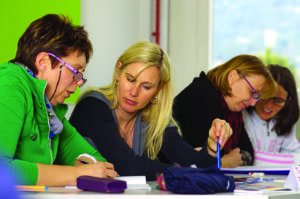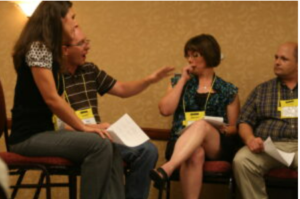Small Group Meetings, Discussions, and Presentations
Small Group Meetings
With a little foresight and careful consideration, you can lead and/or participate in a small group meeting that unifies the team and amplifies the effort of each individual.
Planning Small Group Meetings

Most of us have experienced frustration with meetings that were poorly planned, attended, or executed. They can seem like a waste of time. Conversely, meetings have the potential to be highly productive and help a group develop unity and creativity. [1]
Plan Carefully
Before the meeting even begins, group leaders and members need to take time to clarify the purpose and goal of the meeting and how and when it will happen. In some cases, group members or leaders might determine that a meeting doesn’t need to happen at all. Perhaps a quick phone call, a shared document, a group email, or a meeting of only certain group members would be more effective than scheduling an entire group meeting. Using the example of the group project in a research methods class, a group text or email could be used to set up a schedule or for group members to sign up for different parts of the project, rather than scheduling a meeting for that purpose.
Clarify Roles
To use everyone’s time efficiently, a group leader or the meeting planner should communicate each person’s roles in advance. For example, Carl has agreed to schedule and plan meetings for the group project. Before the meeting, he asks Mehta to present the findings from the group text; Sonny to take notes and Darla, who has graphic design skills, to mockup some graphics for their project.
Create an Agenda
An agenda should be sent to all meeting participants in advance and include the date, time, location (or virtual link), and length of meeting. It typically includes a detailed schedule or checklist of what the meeting plans to address and a list of any materials that need to be reviewed in advance. Prior to the research group’s second meeting, Carl emails the time and location of the meeting along with a list of the topics and tasks they will address.
Managing Small Group Meetings
The tips for managing small group meetings are adapted from O’Hair and Wiemann’s text, Real Communication [2]
Come Prepared
Group members need to show up on time, having reviewed the agenda and completed any tasks they were assigned. For a group project, group members need to have read the assignment carefully and have a clear idea of what is expected. They may have done some initial brainstorming about the group project so they have ideas to present.
Stay Focused

When group members have a clear agenda and goal for their meeting, they are more likely to stay focused. If the discussion goes off-track or some members spend an unnecessary length of time on one topic, members can use the agenda or goal to refocus. For example, in the research methods group, Silvia might say, “I know we’re all concerned about the presentation, but that’s not for six weeks, and right now, our main goal is to figure out our research question and methodology.” On the other hand, during a meeting, goals might shift and be re-defined, so that focus often needs to be balanced with flexibility and a willingness to change plans. For example, the research methods group might be meeting to choose a methodology, and then realize they need to first choose a research topic. In that case, the group might pause and spend 10 minutes determining their topic. Finally, staying focused involves watching the time and managing time limits for each part of the agenda.
Pause and Summarize
During discussions and decision-making, it is invaluable for a group member or leader to pause regularly and summarize what’s happening. In the research methods group, Joe might say, “It sounds like we’re all on board to move ahead with the topic ‘Sleep habits of high school seniors.’ Are we all in agreement and if so, are we OK to move on to developing our research questions?” These types of pauses and summaries allow group members to clarify what’s happening and avoid misunderstandings. They also provide an opportunity to determine the next steps and assign tasks.
Manage Conflict

Disagreements about roles, goals, and processes are entirely normal and expected in small groups. Productive conflict includes questioning or challenging ideas and providing alternative perspectives or new ways of thinking. Managing conflict by consensus is generally more effective than a majority vote. Consensus involves everyone in the small group agreeing to a final decision before moving on. While this is often time consuming, a consensus approach gives voice to all group members who will then be more invested in the final decision. In the research methods class group, the first meeting might be spent debating the merits of different possible topics for the group project. An emergent or assigned leader might elicit input from each group member and create a pros and cons list of each idea.
Follow-Up
Note-taking during the meeting can help with accurate and timely follow-up. An email or other message sent to all group members shortly after the meeting with notes, assignments, and deadlines can not only remind and focus the group, but also verify that everyone left the meeting with similar perceptions of next steps. The follow-up email can also be a useful starting point for creating an agenda for the next meeting.
Small Group Discussions
Because small groups are interdependent, each member needs to participate ethically and fully in discussions. Some strategies to take part in group discussion are geared towards group leaders while others apply to all group members (keeping in mind that all group members might take on leadership roles at different points). The following tips can help create effective small group discussions.
Commit to the Group’s Goals

Individual members need to “align their personal goals with the group’s goals”[3]. When group members have personal agendas that contradict those of the group, there are going to problems. For example, if Uncle George is on the family reunion planning team and wants to rent out his vacation cabin at a mark-up for the reunion so he can make some money, his goals contradict those of the group. If a cousin agrees to join the planning group to get back at a family member whom they dislike, that goal will likely lead to some problems. Because small groups are interdependent, the actions or hidden agendas of individual members can jeopardize the success of the group.
Complete Your Tasks
A small group’s success in achieving its goals is reliant on individual members completing their assignments. Completing tasks of course involves following through on any assigned tasks, but also paying attention during discussions to fully understand what is expected and who will be doing what. If Aunt Nancy is distracted and texting during the reunion group’s discussion about meal planning, she might agree to a task that she does not fully understand and can’t deliver on. Each member needs to listen carefully and do their best to fulfil each assignment.
Avoid Interpersonal Conflict
Productive conflict is natural and needed in group discussion. Debating or questioning the merits of ideas and decisions is a necessary and healthy part of small group discussion and decision-making. However, personal attacks or fighting undermines a group’s unity and success. When Cousin Maria proposes a rental house that far exceeds the group’s budget, Uncle Markus could say, “Are you crazy? We’re not all as rich as you are, thanks to your shady businesses!” That is obviously a personal attack that can likely lead to bad feelings and a lack of unity. In contrast, Uncle Markus might respond, “That rental will not work with the budget we put together last week. Let’s look at some options that we like but will fit in our budget.” This response disagrees with the content of Cousin Maria’s proposal rather than attacking her character.
Encourage Full Participation

Full participation by all members of a small group is most likely to happen when there’s a climate of respect, listening, and openness. Supportive communication and positive feedback, even when disagreeing, will help more shy or inexperienced group members feel comfortable participating. Arriving to any discussion or meetings prepared will likewise encourage participation. Following an agenda with assignments for different topics can also ensure every member’s voice is heard. Even then, personality, background, and cultural factors might mean some members are more vocal than others. In some meetings of discussions, the group leader might ask each member to comment individually on a topic. If the family reunion committee assigned each member a specific role, they could each report updates on their progress at the beginning of the meeting. The meeting or discussion could conclude with asking each member for feedback on a specific topic.
Keep on Track
As mentioned in the previous section, an agenda can help small group discussions encourage full participation from all members, but it also helps the discussion stay focused on the group’s goals and tasks. Some banter and side comments can be fun and promote closeness in the group. However, if the discussion goes too off-track, the group can lose focus, waste time, and not accomplish its goals. It’s the responsibility of each member to pay attention and step in to keep on track. When Uncle Markus starts complaining about everyone’s food sensitivities at length during the reunion meeting about meals, Aunt Nancy might interject, saying, “We know there are several allergies and food preferences, so let’s look at this list of meals I compiled and decide which ones we want to include.”
Presenting as a Group
A small group is often a problem-solving group that researches a situation or problem and presents their conclusions and recommendations. This presentation might take different forms including an individual reporting, a group presentation, or a panel discussion.[4]
Regardless of the particular method of delivery, all the elements of outstanding public speaking apply. These elements include a logical structure; an engaging introduction and strong conclusion; well-supported main points; and clear, descriptive language. In terms of delivery, having excellent eye contact, vocal variety, an open posture, and animated features all combine to effectively convey the group’s message.
Individual Report

Although the entire small group has participated in researching and discussing a particular project or objective, oftentimes one person will be designated to present the findings or recommendations. This person might be a group leader or a member who enjoys or has experience presenting. Ideally, the entire group would assist in putting together the presentation so that it is balanced, easy to follow, and well supported. Both the main presenter and the group members might be called upon to answer questions both before and after the presentation. Depending on the tone and setup of the presentation, group members might chime in to clarify any points, so long as they don’t take over the presentation.
Symposium
“A symposium is a public presentation in which several people present prepared speeches on different aspects of the same topic” (Lucas, 2020, p. 387). If your small group presents a symposium, you need to decide in advance who will present which aspect of your findings or project and practice in advance. Sometimes, the group leader will act as a moderator to introduce the group and segue between each speaker. Other times, each speaker will conclude their remarks by introducing the next speaker: “now that I’ve talked about the risks of adopting our proposal, I’ll turn the time over to Raj to discuss how we hope to address those risks.” In a symposium, each speaker needs to plan their time carefully so they don’t take over other presenters’ allotted time.
Panel Discussion

Like a symposium, a panel discussion draws on some or all members of a small group to present. Unlike a symposium, a panel discussion tends to be more informal and conversational, with a moderator introducing each panelist, asking questions and facilitating the discussion. Like all public speakers, panelists should be well prepared with their content and confer with other panelists in advance, possibly bringing along notes to refer to. However, the tone should still be more spontaneous and discussion oriented with some back-and-forth among panelists and with the moderator. A panel discussion often involves a question-and-answer period with the audience. When asked questions, panelists should listen carefully to each question, keep their responses relatively brief, and be sure they’ve clearly understood and responded to any questions.
- O'Hair, Dan, and Wiemann, Mary. Real Communication: An Introduction. Bedford/St. Martin's, 2012. ↵
- O'Hair, Dan, and Wiemann, Mary. Real Communication: An Introduction. Bedford/St. Martin's, 2012. ↵
- Lucas, Stephen. The Art of Public Speaking. United States, McGraw-Hill Education, 2020, p. 377. ↵
- Lucas, Stephen. The Art of Public Speaking. United States, McGraw-Hill Education, 2020. ↵
